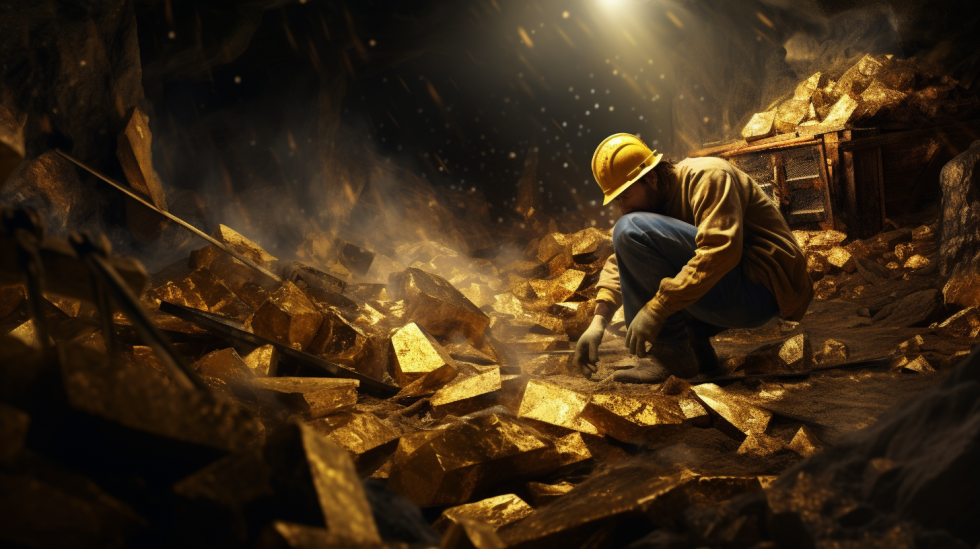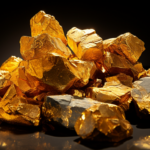Gold mining has been a cornerstone of human civilization for millennia, fueling economies, shaping cultures, and sparking historic rushes. But how is this precious metal actually extracted from the Earth? Gold mining methods have evolved over the centuries, from simple techniques like panning to sophisticated industrial processes. In this exploration of gold mining methods, we’ll journey through the ages to uncover the ingenious ways humans have unearthed and extracted gold.

The Age-Old Art of Panning
One of the most iconic and ancient methods of gold mining is the art of panning. This simple yet effective technique dates back thousands of years and is still used today by small-scale miners and recreational prospectors.
Equipment
- Gold Pan: A shallow, flat-bottomed pan made of metal or plastic. It typically has riffles or grooves on the bottom to trap gold particles.
- Water: A steady supply of water is essential for the panning process.
How It Works
- Filling the Pan: The prospector fills the gold pan with gravel, sand, and sediment from a streambed or riverbank.
- Submerging the Pan: The pan is submerged in water, and the prospector swishes it around to break up the material and allow the water to wash away the lighter particles.
- Rinsing and Agitating: The prospector continues to agitate the pan, allowing the water to wash away the lighter materials while leaving behind the denser gold particles. The riffles help trap the gold.
- Retrieving Gold: After several rounds of rinsing and agitating, the prospector will be left with a small concentration of heavy materials, including gold. This is carefully collected.
- Final Cleanup: The collected material is then carefully examined for any remaining gold particles.
Pros and Cons
Pros:
- Low cost and minimal equipment required.
- Suitable for remote or small-scale operations.
- Ideal for prospecting and initial exploration.
Cons:
- Limited capacity for processing large volumes of material.
- Labor-intensive and time-consuming.
- Less effective for fine gold particles.
The Sluice Box: Gravity Concentration
The sluice box is another traditional gold mining method that relies on gravity concentration to separate gold from other materials. It is an improvement over panning in terms of processing larger volumes of material.
Equipment
- Sluice Box: A long, narrow trough with riffles or cleats on the bottom to trap gold. It is often placed at a slight angle to allow water to flow through.
- Water Supply: A constant flow of water is necessary to transport material through the sluice.
How It Works
- Material Feed: A mixture of gravel, sand, and sediment is fed into the top of the sluice box.
- Gravity Separation: As water flows through the sluice, it carries material along with it. The riffles in the sluice box slow down the flow, creating eddies and allowing gold to settle to the bottom, while lighter materials are washed away.
- Gold Collection: Gold particles become trapped in the riffles, forming a concentrate.
- Cleanup: Periodically, the sluice box is shut off, and the concentrate is collected, typically in a container called a “gold pan.”
Pros and Cons
Pros:
- Can process larger volumes of material than panning.
- Relatively simple and efficient.
- Well-suited for alluvial deposits.
Cons:
- Requires a constant water supply.
- Less effective for fine gold particles.
- Not suitable for all types of gold deposits.
The Rocking Horse: Rocker Box
The rocker box, also known as a cradle, is a manually operated device that uses a rocking motion to separate gold from other materials. It was widely used during the California Gold Rush in the mid-1800s.
Equipment
- Rocker Box: A rectangular wooden box mounted on rockers or cradles, allowing it to be rocked back and forth.
- Material Hopper: A device at the top of the rocker box for feeding material.
- Riffles and Matting: These components inside the box help trap gold.
How It Works
- Material Feed: Gravel, sand, and sediment are fed into the material hopper.
- Rocking Motion: The operator rocks the rocker box back and forth, creating a gentle shaking motion. This causes the heavier gold particles to settle in the riffles.
- Gold Collection: Gold particles are trapped in the riffles and matting.
- Cleanup: Periodically, the rocker box is stopped, and the collected material is examined for gold.
Pros and Cons
Pros:
- Requires minimal equipment and water.
- Effective for small-scale operations.
- Can process a moderate amount of material.
Cons:
- Limited capacity compared to more modern methods.
- Less efficient for fine gold.
- Labor-intensive.
The Industrial Revolution: Hard Rock Mining
The Industrial Revolution brought about a seismic shift in gold mining methods. As demand for gold surged, miners turned to more mechanized and efficient processes to extract gold from hard rock deposits. Hard rock mining involves extracting gold from solid rock, as opposed to alluvial or placer deposits.
Equipment
- Drilling Equipment: To create holes for explosives.
- Explosives: Used to break up the rock.
- Crushing and Grinding Equipment: To reduce the rock to a manageable size.
- Gravity Concentration Equipment: Such as shaking tables or centrifugal concentrators.
- Chemical Extraction Equipment: Used in processes like cyanidation.
How It Works
- Drilling: Miners drill holes into the solid rock to create blast holes.
- Blasting: Explosives are placed in the blast holes and detonated to break up the rock.
- Crushing and Grinding: The broken rock is then crushed into smaller pieces and ground to a fine powder.
- Gravity Concentration: Gravity-based methods like shaking tables or centrifugal concentrators are used to separate gold from the crushed rock.
- Chemical Extraction: In some cases, chemical methods such as cyanidation are used to dissolve and recover gold from finely ground ore.
Pros and Cons
Pros:
- Suitable for extracting gold from hard rock deposits.
- Can process large volumes of ore.
- More efficient and productive than earlier methods.
Cons:
- Requires significant capital investment in equipment.
- Environmental concerns related to chemical extraction methods.
- Complex and highly regulated.
The Subterranean World: Underground Mining
Underground mining is a specialized form of hard rock mining that involves extracting gold from deep underground deposits. It is one of the most complex and demanding forms of gold mining.
Equipment
- Shafts and Tunnels: To access underground deposits.
- Drilling and Blasting Equipment: For creating tunnels and extracting ore.
- Haulage and Transportation Equipment: To move ore to the surface.
- Processing Equipment: Similar to that used in hard rock mining.
How It Works
- Accessing the Deposit: Miners create shafts or tunnels to reach the underground gold deposit.
- Drilling and Blasting: Miners use drilling equipment to create holes in the rock, and explosives are then placed in these holes and detonated to break up the rock.
- Extraction: Once the rock is broken, miners extract the ore, which contains gold, using various methods such as drilling and blasting, sublevel stoping, or cutting and filling.
- Haulage and Transportation: The extracted ore is transported to the surface using haulage equipment like conveyor belts, skip hoists, or underground rail systems.
- Processing: Similar to hard rock mining, the extracted ore is crushed, ground, and processed using gravity concentration and chemical extraction methods to recover the gold.
Pros and Cons
Pros:
- Accesses deep and valuable gold deposits.
- Offers better safety conditions compared to historical underground mining.
- Allows for efficient extraction of ore with higher gold concentrations.
Cons:
- Requires extensive infrastructure and equipment.
- Complex and hazardous working conditions.
- Expensive and resource-intensive.
Modern Gold Mining: Technological Advancements
Today, gold mining has evolved into a highly technological and efficient industry. Innovations in exploration, extraction, and processing methods have revolutionized the way gold is mined.
Advanced Exploration Techniques
- Remote Sensing: Satellite imagery and remote sensing technology are used to identify potential gold deposits based on geological features and mineral signatures.
- Geophysical Surveys: Advanced geophysical techniques, like ground-penetrating radar and electromagnetic surveys, provide insights into subsurface geology.
- Drilling Technology: Modern drilling equipment allows for more precise and efficient exploration, reducing the need for extensive drilling.
Sustainable Mining Practices
- Energy Efficiency: Mining companies invest in energy-efficient equipment and practices to reduce carbon emissions and operating costs.
- Water Management: Advanced water treatment and recycling systems minimize water consumption and pollution, addressing environmental concerns.
- Reclamation: Responsible mining companies are committed to reclamation efforts, restoring mined areas to their natural state and minimizing long-term environmental impacts.
- Certification Programs: Initiatives like the Responsible Gold Mining Principles (RGMP) and Fairmined certification promote ethical and sustainable gold mining practices, ensuring compliance with environmental and social standards.
Innovation in Gold Processing
- Bioleaching: Bioleaching uses microorganisms to extract gold from ores, reducing the need for hazardous chemicals like cyanide. This environmentally friendly method is gaining popularity.
- Gravity Separation: Enhanced gravity separation techniques can efficiently recover fine gold particles, increasing overall gold recovery rates.
- Green Chemistry: Researchers are actively exploring green chemistry alternatives to traditional gold extraction methods, aiming to minimize environmental impacts.
Conclusion: A Tapestry of Techniques
Gold mining methods have come a long way, from the rudimentary panning of ancient civilizations to the cutting-edge technologies of today’s mining industry. The evolution of these methods reflects not only human ingenuity but also the enduring allure and economic importance of this precious metal.
As we examine the tapestry of techniques that make up the world of gold mining, we gain a deeper appreciation for the complexity and diversity of approaches used to extract and recover this remarkable metal. From the romanticized days of gold rushes to the modern era of sustainable and responsible mining, the pursuit of gold continues to shape economies, cultures, and landscapes.
While challenges and environmental considerations persist, the ongoing innovations and commitment to ethical practices within the industry offer hope for a more sustainable future. As gold mining methods continue to evolve, they will play a pivotal role in the ongoing quest to harness Earth’s treasures while preserving its natural beauty.



